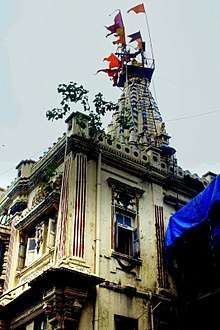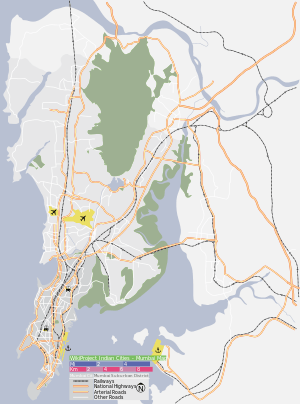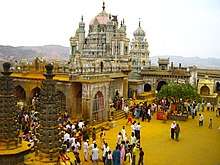Mumba Devi Temple
Mumba Devi Mandir is an old temple in the city of Mumbai, Maharashtra, India dedicated to the goddess Mumbā, the local incarnation of the Devi (Mother Goddess). Marathi Mumbā derives from Sanskrit While Hindu sects devoted to the goddess Mumbadevi are attested to as far back as the 15th century, it is said that the temple was built in 1675 near the main landing site of the former Bori Bunder creek against the north wall of the English Fort Saint George by a Hindu woman also named Mumba. The creek and fort are now deteriorated to a point at which they are but derelict reminders of the city's past. The temple, on the other hand, is still active.[1]
| Mumba Devi Temple Complex | |
|---|---|
 | |
| Religion | |
| Affiliation | Hinduism |
| District | Mumbai City |
| Deity | Mumbadevi Maha Amba Devi |
| Festivals | Navratri |
| Location | |
| Location | Bhuleshwar |
| State | Maharashtra |
| Country | |
 Location within Mumbai, Maharashtra | |
| Geographic coordinates | 18°57′0″N 72°49′48″E |
| Architecture | |
| Completed | 1635 |
The goddess Mumba was patron of the Marathi-speaking agris (salt collectors) and kolis (fisherfolk),[2] the original inhabitants of the seven islands of Bombay. She is depicted as a black stone sculpture in the temple. An etymology of Mumba that is popular is "Maha Amba," or "Great Mother," one of the many of India's more well-known names for the Hindu Mother Goddess (Devi). Located in Bhuleshwar area in South Mumbai, the temple is in the heart of the steel and clothing markets. It is a sacred pilgrimage spot and place of worship for Hindus and is thus visited daily by hundreds of people. It is not uncommon for visitors of Mumbai to pay their respects at the temple and is one of the tourist attractions[3] of Mumbai.
History
This temple was built in honour of the Goddess Amba. The Mumbadevi temple is six centuries old. The first Mumbadevi temple was situated at Bori Bunder, and is believed to have been destroyed between 1739 and 1770. After the destruction a new temple was erected at the same place at Bhuleshwar. The Goddess personifies Mother Earth and is still worshipped by the Hindu population of the northern Indo-Gangetic plain and southern India alike. The original temple built at the site where the Victoria Terminus station earlier was by Koli fishermen was demolished around 1737 and a new temple was erected in its place at Phansi Talao. The modern shrine contains an image of the Goddess Mumbadevi dressed in a robe with a silver crown, a nose stud and a golden necklace. To the left is a stone figure of Annapurna seated on a peacock. In front of the shrine is a tiger, the carrier of the Goddess.
The present name of the city is derived from the Goddess Mumbadevi. The temple itself is not impressive but is an important landmark as it is dedicated to MumbaDevi, the city's patron deity.
Legend
The temple is dedicated to goddess parvati( also known as gauri ) in her Fisher woman form. To take the form of mahakali, goddess parvati had to gain perseverance and concentration. At that time lord shiva (husband of goddess parvati) insisted goddess parvati to reincarnate in the form of a fisher woman by which she can gain the ability of perseverance and concentration as a fisherman gains both these qualities while learning fishing . Goddess parvati then incarnated as a fisher woman and took hermitage at the place of fishermen (current location -- Mumbai) Goddess parvati at her early age was known as Matsyaa and later she was came to be known as Mumba in her Fisher woman form. Mumba dedicated herself in learning perseverance and concentration under the guidance of fishermen as they were keen in their profession of catching fishes by concentration and perseverance. When Mumba mastered the techniques of perseverance and concentration, the time came for her when she had to return to her abode from where she belonged. Lord shiv came in the form of fisherman' and married Mumba realising her who she was. Later the fishermen requested her to stay there forever and thereafter she became the village goddess(grama devata) for the people living there. As she was signified as AAI (meaning mother in Marathi) by the people living there, she came to be known as Mumba Aai. And Mumbai got its name from her.
Places to see
The Mumbadevi road is to the right from the northern end of Zaveri Bazaar. It is a narrow street lined with stalls selling a spectrum of objects associated with Hindu religion – copper bracelets, rings, rudrakska malas, brass lingams, photographs of deities, incense, saffron and so on. Ochre clad sadhus flit along the street, their foreheads smeared with ash paste and vermilion.
References
| Wikimedia Commons has media related to Mumba Devi Temple. |
- "MLA protests against temple Management". DNA India. Mumbai. 19 September 2017. Retrieved 20 October 2017.
- http://nirc.nanzan-u.ac.jp/nfile/1064
- tourist info

